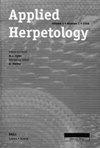Optimising the sampling of skinks using artificial retreats based on weather conditions and time of day
引用次数: 32
Abstract
Artificial retreats are a low-cost, low-impact and effective technique for detecting cryptic taxa, such as herpetofauna, and have potential as a monitoring tool. The success of using artificial retreats for monitoring is dependent on our ability to maximise detection and minimise variability in sightings within a sampling period. Because ectotherms use retreats for their thermal properties, it may be possible to identify weather conditions during which animals consistently use retreats and design a monitoring protocol based on optimal conditions. We investigated the use of artificial retreats by common skinks, Oligosoma polychroma, in mixed grassland habitat in southern New Zealand under various weather conditions and at a range of times of day. We recorded 1175 sightings of skinks during 1800 artificial retreat checks over a nine day period in early summer 2008. Ambient temperature, rainfall, humidity and time of day were the strongest predictors of skink sightings beneath retreats. Skink sightings were highest and least variable: (1) in an ambient temperature range of 12-18°C, (2) during light or no rain, and (3) at low levels of relative humidity. Under optimal weather conditions, skink counts were similar during the day (8 a.m. to 5 p.m. inclusive) but lower during the evening (8 p.m.). Observer variability, type of substrate beneath the retreat and retreat colour did not significantly influence the number of skinks sighted. We highlight the need to optimise protocols for checking artificial retreats on a species- and site-specific basis before attempting to evaluate their use as a monitoring tool for herpetofauna.根据天气条件和时间,利用人工撤退优化石龙子的采样
人工退群是一种低成本、低影响、有效的隐蔽类群探测技术,具有潜在的监测潜力。使用人工撤退进行监测的成功取决于我们在采样周期内最大限度地检测和最小化目击变化的能力。由于变温动物利用休养所来提高它们的热性能,因此有可能确定动物持续使用休养所的天气条件,并根据最佳条件设计监测方案。我们调查了新西兰南部混合草地栖息地中常见石龙子(Oligosoma polychroma)在不同天气条件和一天中不同时间的人工撤退。2008年初夏,在为期9天的1800次人工撤退检查中,我们记录了1175次石龙子目击事件。环境温度,降雨量,湿度和一天中的时间是在撤退下发现石龙子的最强预测因子。(1)在12-18°C的环境温度范围内,(2)在下雨或无雨的情况下,(3)在相对湿度较低的情况下,石龙子的目击率最高,变化最小。在最佳天气条件下,石龙子的数量在白天(早上8点到下午5点包括在内)相似,但在晚上(晚上8点)较低。观察者的可变性、后退的底物类型和后退的颜色对看到的石龙子数量没有显著影响。我们强调,在试图评估人工撤退作为一种监测爬虫动物的工具之前,需要在特定物种和地点的基础上优化检查人工撤退的方案。
本文章由计算机程序翻译,如有差异,请以英文原文为准。
求助全文
约1分钟内获得全文
求助全文

 求助内容:
求助内容: 应助结果提醒方式:
应助结果提醒方式:


